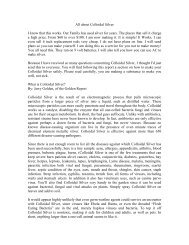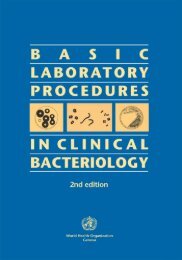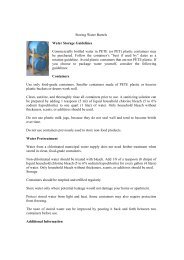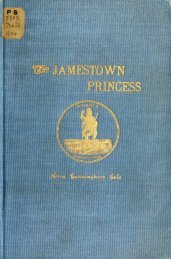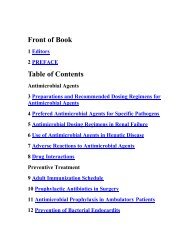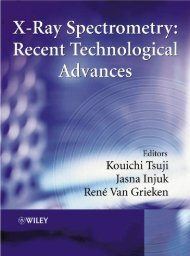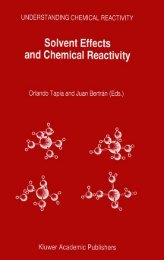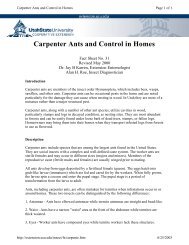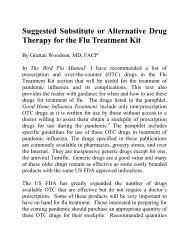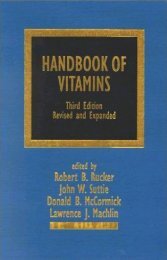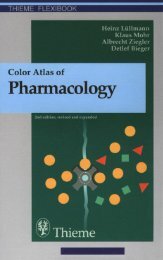- Page 1 and 2: Bacteria from Fish and Other Aquati
- Page 3 and 4: Contents List of Tables and Figures
- Page 5 and 6: List of Tables and Figures Tables T
- Page 7 and 8: Foreword While aquatic animal disea
- Page 9: Acknowledgements xi Principal spons
- Page 13 and 14: Photographs of Culture and Microsco
- Page 15 and 16: Fig. 11. Aeromonas veronii ssp. sob
- Page 17 and 18: Fig. 22. Edwardsiella tarda on BA,
- Page 19 and 20: Fig. 43. Listonella anguillarum, Gr
- Page 21 and 22: Fig. 55. Plesiomonas shigelloides,
- Page 23 and 24: Fig. 69. Vibrio alginolyticus, Gram
- Page 25 and 26: Fig. 82. Vibrio harveyi on MSA-B, 4
- Page 27 and 28: Fig. 98. Vibrio proteolyticus on BA
- Page 29 and 30: Fig. 118. Methyl Red reaction. Posi
- Page 31 and 32: 2 Chapter 1 Table 1.1. Host species
- Page 33 and 34: 4 Chapter 1 Table 1.1. Continued. H
- Page 35 and 36: 6 Chapter 1 Table 1.1. Continued. H
- Page 37 and 38: 8 Chapter 1 Table 1.1. Continued. H
- Page 39 and 40: 10 Chapter 1 Table 1.1. Continued.
- Page 41 and 42: 12 Chapter 1 Table 1.1. Continued.
- Page 43 and 44: 14 Chapter 1 Table 1.1. Continued.
- Page 45 and 46: 16 Chapter 1 Table 1.1. Continued.
- Page 47 and 48: 18 Chapter 1 Table 1.1. Continued.
- Page 49 and 50: 20 Chapter 1 Table 1.1. Continued.
- Page 51 and 52: 22 Chapter 1 Table 1.1. Continued.
- Page 53 and 54: 24 Chapter 1 Table 1.1. Continued.
- Page 55 and 56: 26 Chapter 1 Table 1.1. Continued.
- Page 57 and 58: 28 Chapter 1 Table 1.1. Continued.
- Page 59 and 60: 30 Chapter 1 Table 1.1. Continued.
- Page 61 and 62:
32 Chapter 1 Table 1.1. Continued.
- Page 63 and 64:
34 Chapter 1 Table 1.1. Continued.
- Page 65 and 66:
36 Chapter 1 Bacterial gill disease
- Page 67 and 68:
38 Chapter 1 Table 1.2. Bacterial p
- Page 69 and 70:
40 Chapter 1 Table 1.2. Continued.
- Page 71 and 72:
42 Chapter 1 Table 1.2. Continued.
- Page 73 and 74:
44 Chapter 1 Table 1.2. Continued.
- Page 75 and 76:
46 Chapter 1 Table 1.2. Continued.
- Page 77 and 78:
48 Chapter 1 Table 1.2. Continued.
- Page 79 and 80:
50 Chapter 1 Table 1.2. Continued.
- Page 81 and 82:
52 Chapter 1 Table 1.2. Continued.
- Page 83 and 84:
54 Chapter 1 Table 1.2. Continued.
- Page 85 and 86:
56 Chapter 1 Table 1.2. Continued.
- Page 87 and 88:
58 Chapter 1 Table 1.2. Continued.
- Page 89 and 90:
60 Chapter 1 Table 1.2. Continued.
- Page 91 and 92:
62 Chapter 1 Table 1.2. Continued.
- Page 93 and 94:
64 Chapter 1 Table 1.2. Continued.
- Page 95 and 96:
66 Chapter 1 Table 1.2. Continued.
- Page 97 and 98:
68 Chapter 1 Table 1.2. Continued.
- Page 99 and 100:
70 Chapter 1 Table 1.2. Continued.
- Page 101 and 102:
72 Chapter 1 Table 1.2. Continued.
- Page 103 and 104:
74 Chapter 1 Table 1.2. Continued.
- Page 105 and 106:
76 Chapter 1 of the test, or the us
- Page 107 and 108:
78 Chapter 1 in a similar manner to
- Page 109 and 110:
80 Chapter 1 phenotypic results rec
- Page 111 and 112:
82 Chapter 1 formerly Y. enterocoli
- Page 113 and 114:
84 Chapter 2 2.1 Specimen Collectio
- Page 115 and 116:
86 Chapter 2 Table 2.3. Specific cu
- Page 117 and 118:
88 Chapter 2 Table 2.3. Continued.
- Page 119 and 120:
90 Chapter 2 Table 2.3. Continued.
- Page 121 and 122:
92 Chapter 2 Table 2.4. Continued.
- Page 123 and 124:
94 Chapter 2 Table 2.4. Continued.
- Page 125 and 126:
96 Chapter 2 Table 2.4. Continued.
- Page 127 and 128:
98 Chapter 2 Table 2.4. Continued.
- Page 129 and 130:
100 Chapter 2 Table 2.4. Continued.
- Page 131 and 132:
102 Chapter 2 Table 2.4. Continued.
- Page 133 and 134:
104 Chapter 2 Table 2.4. Continued.
- Page 135 and 136:
106 Chapter 2 Table 2.4. Continued.
- Page 137 and 138:
108 Chapter 2 Table 2.4. Continued.
- Page 139 and 140:
110 Chapter 2 Table 2.4. Continued.
- Page 141 and 142:
112 Chapter 2 Table 2.4. Continued.
- Page 143 and 144:
114 Chapter 2 reaction, oxidase and
- Page 145 and 146:
116 Chapter 2 API 20E API 20NE API
- Page 147 and 148:
118 Chapter 3 Table 3.1. Interpreta
- Page 149 and 150:
120 Chapter 3 to produce alkaline p
- Page 151 and 152:
122 Chapter 3 V. splendidus biovar
- Page 153 and 154:
124 Chapter 3 are likely to produce
- Page 155 and 156:
126 Chapter 3 Table 3.2. Carnobacte
- Page 157 and 158:
128 Chapter 3 reported a negative r
- Page 159 and 160:
130 Chapter 3 Table 3.5. Further di
- Page 161 and 162:
132 Chapter 3 to be due to the diff
- Page 163 and 164:
134 Chapter 3 control and a negativ
- Page 165 and 166:
136 Chapter 3 Yersinia ruckeri Stra
- Page 167 and 168:
138 Chapter 4 Fig. 4.1. Schematic f
- Page 169 and 170:
140 Table 4.1. Aeromonas salmonicid
- Page 171 and 172:
142 Table 4.3. Aeromonas spp. - mot
- Page 173 and 174:
144 Table 4.5. Brucella spp. Test G
- Page 175 and 176:
146 Table 4.8. Cytophaga-Flavobacte
- Page 177 and 178:
148 Table 4.8. Continued. Test Gm O
- Page 179 and 180:
150 Table 4.10. Continued. Test Gm
- Page 181 and 182:
152 Table 4.10. Continued. Test Gm
- Page 183 and 184:
154 Table 4.11. Continued. Test Gm
- Page 185 and 186:
156 Table 4.11. Continued. Test Gm
- Page 187 and 188:
158 Table 4.11. Continued. Test Gm
- Page 189 and 190:
160 Table 4.13. Gram-positive cocci
- Page 191 and 192:
162 Table 4.13. Continued. Test Gm
- Page 193 and 194:
164 Table 4.14. Gram-positive rods.
- Page 195 and 196:
166 Table 4.15. Mycobacterium and N
- Page 197 and 198:
168 Table 4.17. Mycoplasma spp. Tes
- Page 199 and 200:
170 Table 4.20. Continued. Test Gm
- Page 201 and 202:
172 Table 4.21. Continued. Test Gm
- Page 203 and 204:
174 Table 4.21. Continued. Test Gm
- Page 205 and 206:
176 Table 4.22. Continued. Test Gm
- Page 207 and 208:
178 Table 4.23. API 20E database bi
- Page 209 and 210:
180 Table 4.23. Continued. Tests on
- Page 211 and 212:
182 Table 4.23. Continued. Tests on
- Page 213 and 214:
184 Table 4.24. API 20E database nu
- Page 215 and 216:
186 Table 4.24. Continued. Organism
- Page 217 and 218:
188 Table 4.24. Continued. Organism
- Page 219 and 220:
190 Table 4.25. API 20E database nu
- Page 221 and 222:
192 Table 4.25. Continued. API 20 E
- Page 223 and 224:
194 Table 4.25. Continued. API 20 E
- Page 225 and 226:
196 Table 4.25. Continued. API 20 E
- Page 227 and 228:
198 Table 4.26. Continued. Listonel
- Page 229 and 230:
200 Table 4.27. API 50CH database b
- Page 231 and 232:
202 Table 4.27. Continued. 1 2 3 4
- Page 233 and 234:
204 Table 4.27. Continued. 1 2 3 4
- Page 235 and 236:
206 Table 4.27. Continued. 1 2 3 4
- Page 237 and 238:
208 Table 4.28. API Coryne database
- Page 239 and 240:
210 Table 4.30. API Rapid ID32 Stre
- Page 241 and 242:
212 Table 4.31. API ZYM database re
- Page 243 and 244:
214 Table 4.31. Continued. Well 1 2
- Page 245 and 246:
216 Table 4.31. Continued. Well 1 2
- Page 247 and 248:
218 Table 4.32. Strains quoted in r
- Page 249 and 250:
220 Table 4.32. Continued. Organism
- Page 251 and 252:
5 Technical Methods 5.1 Total Bacte
- Page 253 and 254:
224 Chapter 5 Incubation Place plat
- Page 255 and 256:
226 Chapter 6 Table 6.1. List of sp
- Page 257 and 258:
228 Chapter 6 Table 6.1. Continued.
- Page 259 and 260:
230 Chapter 6 Table 6.1. Continued.
- Page 261 and 262:
232 Chapter 6 Edwardsiella spp. PCR
- Page 263 and 264:
234 Chapter 6 Extraction of DNA fro
- Page 265 and 266:
236 Chapter 6 The nucleotides can a
- Page 267 and 268:
238 Chapter 6 Table 6.3. Universal
- Page 269 and 270:
240 Chapter 6 Visualize DNA on agar
- Page 271 and 272:
242 Chapter 6 document with the seq
- Page 273 and 274:
7 Preparation of Media for Culture
- Page 275 and 276:
246 Chapter 7 Blood agar - BA Reage
- Page 277 and 278:
248 Chapter 7 Edwardsiella ictaluri
- Page 279 and 280:
250 Chapter 7 Flexibacter maintenan
- Page 281 and 282:
252 Chapter 7 Marine 2216 agar (Dif
- Page 283 and 284:
254 Chapter 7 Mycoplasma medium - m
- Page 285 and 286:
256 Chapter 7 R2A agar (Oxoid CM 90
- Page 287 and 288:
258 Chapter 7 Siem selective medium
- Page 289 and 290:
260 Chapter 7 VVM Selective medium
- Page 291 and 292:
262 Chapter 7 Brucella: growth on s
- Page 293 and 294:
264 Chapter 7 Carbohydrate fermenta
- Page 295 and 296:
266 Chapter 7 Congo Red. Tests for
- Page 297 and 298:
268 Chapter 7 Furunculosis agar (Fo
- Page 299 and 300:
270 Chapter 7 Indoxyl acetate hydro
- Page 301 and 302:
272 Chapter 7 Glucose (10% w/v) 10
- Page 303 and 304:
274 Chapter 7 ONPG - o-nitrophenyl-
- Page 305 and 306:
276 Chapter 7 Salt - 20% stock solu
- Page 307 and 308:
Further Reading and Other Informati
- Page 309 and 310:
280 Further Reading List of Bacteri
- Page 311 and 312:
282 Appendix Common name Scientific
- Page 313 and 314:
284 Appendix Common name Scientific
- Page 315 and 316:
286 Appendix Common name Scientific
- Page 317 and 318:
288 Glossary C Ca Cat CBBA CCA CCRC
- Page 319 and 320:
290 Glossary O Oxidative (aerobic m
- Page 321 and 322:
References 1 Abbott, S.L., Cheung,
- Page 323 and 324:
294 References otherwise infected w
- Page 325 and 326:
296 References 87 Bergman, S., Seli
- Page 327 and 328:
298 References Journal of Systemati
- Page 329 and 330:
300 References ribonucleic acid seq
- Page 331 and 332:
302 References ‘winter disease’
- Page 333 and 334:
304 References 273 Fukuda, Y., Mats
- Page 335 and 336:
306 References resistance of virule
- Page 337 and 338:
308 References and an emended descr
- Page 339 and 340:
310 References the Enterobacteriace
- Page 341 and 342:
312 References an epizootic of cult
- Page 343 and 344:
314 References 512 Macián, M.C., L
- Page 345 and 346:
316 References Plecoglossus altivel
- Page 347 and 348:
318 References sponge. Internationa
- Page 349 and 350:
320 References fish pathogens. Dise
- Page 351 and 352:
322 References Listonella and reass
- Page 353 and 354:
324 References 750 Toranzo, A.E., B
- Page 355 and 356:
326 References 795 Vreeland, R.H.,
- Page 357 and 358:
328 References 842 Wood, R. (1965)
- Page 359 and 360:
330 Index Aeromonas continued A. ca
- Page 361 and 362:
332 Index API identification system
- Page 363 and 364:
334 Index Brucella agar 246 Brucell
- Page 365 and 366:
336 Index Colony forming units (CFU
- Page 367 and 368:
338 Index Dolphin continued Striped
- Page 369 and 370:
340 Index Flavobacterium species co
- Page 371 and 372:
342 Index Granulicatella continued
- Page 373 and 374:
344 Index Laminaria 59 Laminaria ja
- Page 375 and 376:
346 Index Mycobacterium continued M
- Page 377 and 378:
348 Index Peled see Whitefish Pelec
- Page 379 and 380:
350 Index Pseudoalteromonas continu
- Page 381 and 382:
352 Index Salmonella continued S. j
- Page 383 and 384:
354 Index Shewanella marine agar (S
- Page 385 and 386:
356 Index Strontium chloride B enri
- Page 387 and 388:
358 Index Vibrio continued V. brasi
- Page 389 and 390:
360 Index Vibrio continued V. scoph



